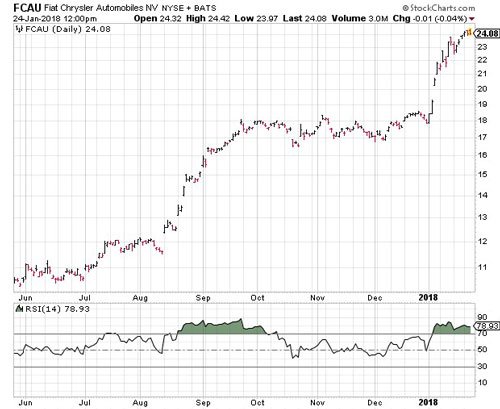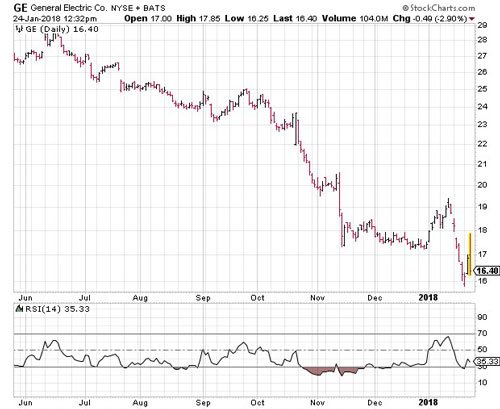Plenty of regular investors might not pay much attention to technical analysis ("charts," to use the popular word). It's just as likely they might follow "technicians" who do their own analysis and make the charts available online for mass consumption with their interpretation of the technicals.
Proceed with caution.
There's a danger in technical analysis, in that indicators are often viewed in a vacuum. The "if this occurs, then that will happen" mentality often dominates to the point that technicians, and the traders and investors who are following along, get "trapped" in their analysis.
And that can lose you a lot of money.
I'm going to show you how that happens - and, of course, the right way to go...
[mmpazkzone name="in-story" network="9794" site="307044" id="137008" type="4"]
How This Signal Gets Misused and Abused
One such indicator that I often see misused is the Relative Strength Index (RSI), a measure of momentum that attempts to identify when a stock is "overbought" or "oversold."
The thinking goes, when RSI gets too high, the stock is technically "overbought," and you should either stay away from it or fade the move by shorting or buying a put. Conversely, you should buy a stock that is "oversold."
The idea, of course, is that a stock has had its run - either up or down - and that a reversal is imminent. According the the theory, you're meant to consider RSI a "contrarian technical indicator" that tells you when it's time to go against the trend.
But here's the problem with all this: I don't believe that there is such a thing as a "contrarian technical indicator." Technical indicators use data points and monitor price movement. They don't tap into emotions and expectations that I believe can be used in a contrary fashion.
So, just because RSI is above 70 (the common threshold for being "overbought), it doesn't mean you should try and fade (short) the stock. It may be "technically overbought" according to the indicator, but what does that really mean? That the stock has powerful momentum? Is that a bad thing?
Just look at an Amazon.com Inc. (Nasdaq: AMZN) chart. For the past three months, the stock has spent more time in overbought territory than not.
Had you decided to step in front of the "Bezos steamroller" and buy an AMZN put when RSI hit 70 in late October or earlier this month... well, you would have been flattened.

That's why my Fourth Commandment of Trading is: "Cheap can always become cheaper. Expensive can always get more expensive."
That's not to say that RSI is useless. My point is that it shouldn't be considered a binary indicator: above 70 "bad," below 30 "good." Rather, use it in the context of other indicators to get a better picture of whether the momentum has legs.
That's why I use several indicators to identify profit opportunities for my Seismic Profit Alert Members.
Here's How We Do It in My Trading Research Services
For bullish trades, I like to see a stock above a rising 50-day moving average that is sitting above the 200-day moving average. I mix in market expectations, most notably short interest. When the shorts get too active, I see a possible short squeeze that can keep the upward momentum going.
And if RSI is flashing "overbought," I don't care. Because I know Commandment IV tells me - that overbought can become more overbought.
Let me show you how I followed this trading rule in a recent Seismic Profit Alert trade.
TOP PERFORMANCE: Chris showed his paid-up subscribers 589.63% in total winning moves, closed over just five days in January. And he's offering a stunning performance guarantee for those who get in now. Click here...
On Jan. 3, my model was flashing a bullish signal on Fiat Chrysler Automobiles NV (NYSE: FCAU). Why? The 50-day moving average had started to turn up, a pattern similar to one in July that preceded a monster rally. In addition, the shorts were piling into the stock, pushing the short interest ratio to a level that made FCAU likely to benefit from a short-squeeze rally.
But it was Commandment IV that made this trade, because without it, I never would have considered FCAU as a bullish play. You see, the RSI was telling me the shares were technically overbought. Had I followed the "RSI above 70 is bad" rule, FCAU would have been off my radar.
But look what happened in August. The RSI moved above 70 and stayed above that level for six weeks. And all the while FCAU was "overbought," the shares gained more than 40%!
Getting back to my trade, based on my technical and expectational indicators, I recommended a Feb. 16 $18 call on Jan. 3. The stock gapped higher and never looked back. We closed the first half of the trade for 154% and the second half for a whopping 276%, while the RSI continued to rise, peaking above the 80 level (as in, way overbought).

That's right: Our call more than tripled our money while the stock became even more overbought. You gotta love Commandment IV.
Looking ahead, I see several opportunities in stocks that should stay overbought or oversold. One that jumps out at me is General Electric Co. (NYSE: GE).
Now, I don't need to tell you that GE is a train wreck. The stock dropped about 45% in 2017 and has started this year in losing fashion as well. And save for a brief spurt earlier this month, the RSI has stayed in or near oversold levels for the past three months.

This morning's earnings report didn't help matters. The company swung to a loss in the fourth quarter, with revenue dropping from a year earlier. And GE announced the SEC was investigating a charge it took on its insurance portfolio. As I said, a train wreck.
But here's the thing that I don't get. Short interest on the stock is ridiculously low. The short interest ratio is barely above one. And the Street isn't exactly running from GE, as 41% of covering analysts rate the stock a "buy." Maybe they're looking at the RSI and thinking GE is due for a rebound.
I'm not seeing any reason to think this stock is on the cusp of a reversal. With no help from its earnings report, GE is oversold and will stay oversold. That's why I just opened a March 18 $19 put in my own personal account this morning.
I think any investor would clean up buying this put - tell them Commandment IV sent you!
This Earnings Season, Learn How You Could Turn a Small Stake into $31,000 in Just 10 Weeks
Dozens of S&P 500 companies will be making major announcements over the next several weeks that could send shockwaves throughout the market, setting off massive potential price jumps.
Knowing how to get in two full days ahead of the biggest, most promising share-price potential gains is an advantage that's never been available - until now.
Chris Johnson has developed a tool that gives 48-hour advance notice of these kinds of price eruptions - with 100% certainty.
His recommendations this year are off to an incredible start - like 153.59% on FCAU on Jan. 8...
...56.70% on ADBE on Jan. 8... 102.78% on OZRK on Jan. 11...
...and then an additional 276.47% on FCAU on Jan. 12. That's 589.63% total winning moves in just five days!
Right now, Chris is tracking dozens more opportunities that could help you trade your way to some serious cash - fast.
Go here now to see how this works...
Follow Money Morning on Twitter @moneymorning, Facebook, and LinkedIn.
About the Author
Chris Johnson (“CJ”), a seasoned equity and options analyst with nearly 30 years of experience, is celebrated for his quantitative expertise in quantifying investors’ sentiment to navigate Wall Street with a deeply rooted technical and contrarian trading style.



